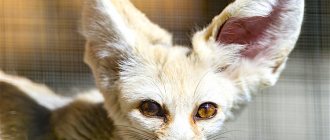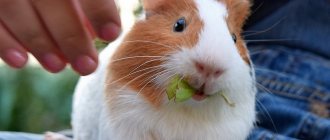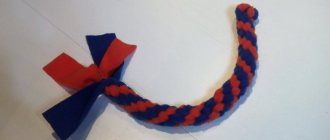The Fennec fox is a very popular animal recently, which is often kept at home. You can learn about all the secrets of the content from the article.
Many people are interested in whether a little Fenech, who lives in the wild, can become the favorite of the whole family at home? The answer to this question is positive. But before you get a fox, you need to have an idea of how to care for it, how to feed it, and what conditions it needs. You will also have to find out in advance how this animal behaves at home, what it needs for normal existence and development.
Domestic Fennec fox: description
- Fenech is a miniature animal that belongs to the genus of foxes in the canine family. The animal, if translated from Arabic, is called “fox”. But the scientific name of the animal is “dry fox.”
- It is from this that you can understand where exactly the animal lives. Places where the fox is found: the desert of the Arabian Peninsula, as well as in many regions of Africa.
- To this day, there is a dispute between scientists - can this animal be called a “fox”? Since the behavior of the animal, its body structure differs from other varieties of foxes.
- The fennec fox does not have the musk glands that other foxes have. She does not like to live alone; this animal is considered social.
fox
is a small animal. It has the following distinctive body features:
- The fox is even smaller than a domestic cat. The height at the withers is no more than 22 cm. The animal’s body is maximum 40 cm long. But the fox’s tail is long, sometimes reaching the same size as the whole body. Fenech's weight is no more than 1 kg 500 g.
- The fox has a pointed muzzle , but its eyes are quite large.
- The animal's ears are large. They can be up to 15 cm in height. But nature did not give these ears to the fox for luxury. Thanks to them, the animal can hear any smallest rustle, and therefore never misses its own prey.
- Fenech can be without water for a long time. But at the same time, the fox must always have food that contains liquid. The main feature of Fenech’s behavior is the ability to jump up to 1 m 20 cm in length and up to 70 cm in height.
Briefly
Interesting Facts
- The most popular fennec fox is the hero of the animated film “Zootopia” named “Finnik” or “Fenech”. It was after the release of this cartoon that people began to more often keep this animal as a pet.
- The Fenech is depicted on the Algerian ¼ dinar coin.
- This animal is a symbol of the ecology of Tunisia. Figures of a fennec fox in a blue and white suit are ubiquitous in almost every city in this country.
- The well-known browser Mozilla Firefox has developed a lightweight version of Mozilla Fennec for smartphones, phones and other mobile devices, where the fennec fox is a mascot and a code word in the name.
- Many desert inhabitants have large ears - the sand cat, the long-eared hedgehog, and the black-tailed hare. Such disproportionately large hearing devices protect desert dwellers from overheating.
- It is interesting that the supra-caudal gland, otherwise called the “violet” gland, is called that for a reason. In the spring, during the period of active search for a mate, the secretion secreted by her actually smells like the aroma of violets. It is unknown why nature gave this secret smell to foxes. Experienced hunters say that if a fox is wounded, it can turn around and inhale this aroma, after which it seems to gain strength. Some kind of particularly persistent pheromone, and at the same time an “energy booster”.
- These animals are fully adapted to life in the desert. They do not require a large amount of water; they can generally do without it for a long time, receiving a sufficient amount of moisture from roots and plants. In addition, they have adapted to lick condensation from the walls of their own vast burrow.
Fenech Fox: care and maintenance at home
- can be easily tamed at home It is easy to maintain; with normal care at home, a fox can even give birth to offspring.
- If you pay attention to the little animal, raise it correctly, and tame it at home, the animal will become obedient. But there are some difficulties in keeping a fox.
- You will have to purchase a large cage or create a separate room with sand on the floor. There the fox will dig a hole for himself.
- A long, difficult period of training Fenech to the tray . If you do not change the sand on time, there may be a bad smell in the house.
- Sometimes it is very difficult to find a specialist who can treat this exotic animal.
- The Fennec fox , like a pet, requires special attention. Due to its easy-going nature, the animal easily gets along with any inhabitants of the home and with other pets.
At home
- But we all know that the fox is a nocturnal inhabitant, therefore, at night its instinct of a real hunter awakens. The animal digs holes in the dark, runs around rooms, and sweeps away everything in its path.
- Make sure that the animal has enough space or even a separate room where the fox will feel comfortable.
Drafts and low room temperatures can be dangerous for your pet. Colds are difficult for foxes to tolerate and cannot always be cured. Therefore, give the animal the necessary vaccinations so that it does not develop an infectious disease.
Wildlife Habitat
The fennec fox lives in places with high air temperatures. For living, the animal chooses thickets of grass or small bushes. It digs holes in the ground in which entire families live, usually up to 10 individuals. The animal is predominantly nocturnal.
Hunts prey alone. It is considered an omnivore because it digs most of its food from the sand. The diet includes insects, fruits and plant rhizomes. Thanks to its excellent hearing, the fennec catches every rustle. No matter where foxes live, they are good hunters.
Feeding the Fennec fox
- In nature, in the wild, the Fennec fox prefers to eat small animals and insects. The diet also contains roots and herbs that grow mainly in the desert.
- Under natural conditions, Fenech eats locusts, beetles, lizards, birds and their eggs, rodents and other small animals . And the fox eats plants only in small quantities. Conclusion: the animal’s diet consists mainly of protein foods.
- At home, you should follow the same dietary rules. If you feed your pet incorrectly, various health problems may arise. The fox's body is built in such a way that it does not process a lot of plant fiber. Keep this in mind, and do not forget, if you give the animal a lot of plant food, it will have problems with digestion.
Nutrition
- In addition, this cute animal has weak jaws and small teeth that are adapted for chewing insects. The animal's nutrition will be closer to its natural diet, and it will feel and develop better. But if the animal’s diet lacks small mammals and insects, it may develop liver disease.
- Your fox should eat large quantities of mealworms, crickets
- Give your fox lean meat in its raw state all the time. If possible, give small mice.
- additional food is vegetables (fresh or frozen). The maximum serving is 2 tsp per day. Please note that the animal should not be given corn, carrots, or grains. The fox's body does not digest such food well.
Catering
- Give fruits in minimal quantities. The animal should receive some treats.
- dried fruits (figs or dates). She will also love cherries.
- But do not forget that Fenech’s main diet should consist only of meat products. The animal needs a diet that contains a lot of protein.
- Keep an eye on the animal's feces. If your fox constantly eats grains and vegetables, you will notice undigested particles of these products in the feces.
- If you have doubts about the animal’s nutrition, you think that it does not receive enough vitamins and minerals, give the fox Vionate . You need to give vitamins only 2 times a week.
- Also add taurine , which comes in capsules. Open one capsule and add the powder to vegetables or worms. Give it like the previous drug.
Reproduction
Fennec cats reach sexual maturity at approximately 6-9 months, and the first mating occurs at the age of 9 months to a year. Fennec foxes are monogamous, permanent pairs last for several breeding seasons.
The mating season of animals begins in January-February. The female's estrus (estrus) is very short: 1-2 days, the pre-estrus period (proestrus) is mainly expressed in swelling of the vulva (external genitalia) and is also short-lived. The activity of the testes in males is synchronized with the cycle of females: their productivity is maximum when the female is in estrus, then decreases.
Courtship behavior during the mating season among fennec cats has been better studied in captivity, since observations in natural conditions (in the desert at night) are extremely difficult to organize. A typical ritual preceding mating consists of noisy flirtations and usually lasts from one to one and a half days. Mating lasts more than an hour, sometimes several times with an interval of several hours.
Data on crossing vary: some sources say that it occurs quite rarely, others say that it occurs frequently and can take up to 165 minutes. In nature, social mechanisms prevent inbreeding, but in captivity fennecs of both sexes can mate with their own offspring.
Pregnancy in fennec cats usually lasts 50-52 days, although there is evidence from zoos of successful births after 62- and 63-day pregnancies. In the wild, puppies are usually born in March-April. In captivity, mating, pregnancy and birth can occur at any time of the year.
However, even in captivity, most pups are born between March and July. Fennecs give birth to one litter per year, but if it is lost, the female may come into heat and become pregnant again. Thus, fenechs cannot be called truly monoestrous animals.
Before, during and after birth, the male protects the hole, but does not enter the nesting chamber: the female at this time is aggressive and selflessly protects the cubs. A female usually gives birth to two to five blind, fur-covered puppies weighing 40-45 g (however, litters with one or six cubs are less common).
The length of the body and head of a one-day-old puppy is 10-12 cm, the length of the tail is 4 cm, the length of the ear is 1 cm. After 8-11 days, the fennec fox opens its eyes, and its weight doubles after 11-12 days. After two weeks, the baby is already able to move, however, it does not immediately leave the hole.
Florence Perroux/La Palmyre Zoo, France
Until the puppies are 4 weeks old, the male actively defends the area near the burrow and brings prey. At this time, the fennec cubs begin to leave the hole, first for a short time, then for an increasingly longer time. By the middle of the 3rd week, milk feeding is also transferred outside. At this time, the babies are teething, and for the first time they try adult food that the male brings them. After the 4th week, the male brings more and more food to the puppies and female, and meat begins to occupy a significant place in the diet of small fennec cats, although feeding with milk continues until 60-70 days.
The simplest hunting behavior appears approximately 7 weeks after birth, as it is trained it becomes more complex and skillful, but until 13 weeks the male brings prey to the burrow. Only at the age of 3 months do puppies begin to move away from the hole, first together with their parents, and then alone. Fenechs reach sexual and physiological maturity at 9-11 months.
The fennec fox, which is a representative of the canine genus, has recently achieved quite great popularity as a pet. This specimen of the animal world is most suitable for home keeping due to its docile nature. Much to the regret of lovers of exotic pets, such animals can rarely be found on sale, unlike , and if this happens, the price will be very important.
How to litter train a Fennec fox?
- A miniature fox, as a rule, lives in a separate room or in a large cage. If you want to train your pet to use a litter box, you will definitely succeed, but some difficulties cannot be ruled out. Sometimes “misses” can happen, especially if the pet is in an excited state.
- There are some animal owners who trained the Fennec fox to wear a diaper. You can use this method if your pet will be constantly in one place.
- Who is better to buy - a girl or a boy Fenech ? What role do spaying and neutering play?
Fennec at home
- If you take a female, then after sterilization her character does not change at all. The same cannot be said about males. They become calm and affectionate.
- Males are by nature more obedient than females. The latter, as a rule, are shy and very nimble. When accustoming a female to the tray, keep in mind that after sterilization, the animal’s urine becomes less pungent in smell.
Hedgehog
Hedgehogs are not rodents, and they are not related to porcupines. They are in the subfamily known as Erinaceinae (originally known as insectivores.) Hedgehogs deserve the number one spot on this list for being the easiest to care for, being "exotic" (although the forms you find in pet stores are somewhat different from wild forms, which makes them domesticated.)
- Hedgehogs are not social, so there should only be one in each enclosure. This makes them pets that are not susceptible to separation anxiety and are suitable for people who travel.
- They are suitable for those who do not want long-lived pets as their lifespan is a courtesy of 5-7 years.
- Hedgehogs have a simplified diet that may consist of high quality prepared foods and/or fruits and insects. They are so common that many pet stores sell food for them.
- Hedgehogs can be somewhat temperamental, but they do well with proper handling and habituation.
- Proper “hedge” accommodations should consist only of a properly sized ground enclosure.
Hedgehogs can even be children's pets due to their easy care. Just be prepared for the cleaning involved with their frequent bowel movements.
How does the Fennec fox play?
- These foxes are quite talkative. They make sounds reminiscent of a dog barking. Fennec foxes also “purr”, sometimes growl, and even snarl. Fennec foxes sometimes make beautiful sounds, similar to birdsong. They do this at night.
- The fox periodically howls pitifully, whines, and grumbles when she wants to play, have fun, and communicate. If you come home and call Fenech to play, the animal will begin to squeal loudly with pleasure.
- At night the fox loves to make noise. Therefore, give her a room located away from the bedroom. There are also quiet individuals. They are able to make calm sounds when greeting their owner in the morning.
You can play
- Many owners let Fenech out of the cage at night so that the animal can walk around the apartment. But it's better not to do this. An unattended fox grabs everything in its mouth, so it can choke.
- Also, the fox often tries to play with its owners and scratch itself with sharp claws.
- But there are Fennec cats that can adapt to the owner’s daily routine. At night they sleep.
If you buy a Fennec fox, you can easily train it to play only during the day. Take care of your pet during the day, in the evening, and play with him. You will notice that by night the animal will run out of energy and the pet will want to sleep. This way, over time, you will teach him to play and lead an active lifestyle only during the day.
- If a fox is constantly alone, it barks. There are also individuals who never do this. They can make sounds that resemble yelps.
- Fenech can yap when excited (while walking outside, when playing with the owner, and so on).
Raising a little fox
Although miniature foxes are close to cats in behavior and character, keeping and raising them is much more difficult.
Of great importance is the age at which the fennec tree comes into your home. The earlier this happens, the easier and more successful the process of taming and education will be. Already at 7-9 months the animal reaches sexual maturity. It is up to this age that it is advisable to take a fennec cat into the house. Then the pet will get used to you and your other pets (if you have any) without any problems.
The fennec fox is a desert dweller and, like many other desert inhabitants, is characterized by a nocturnal lifestyle. During the day the animal will sleep, but at night its hunting instincts and natural curiosity will fully manifest themselves. A fennec cat can run around the house, making an unimaginable noise, make various sounds, try to dig tunnels in the floor or sofa, try wires on its teeth, throw things on the floor, etc. In a word, get ready for the fact that night is the time of peak activity for the fennec, and he will restore order in the house. There is only one way out - to give the fennec a spacious enclosure where he can frolic to his heart's content, or even better - a separate specially equipped room in which you need to try to create conditions for the pet that will be as close to natural as possible.
However, the experience of some owners of these animals shows that with due patience and perseverance, the animal can be taught to sleep at night.
It is hardly possible to raise a fox the same way as a dog. But it won’t be difficult to respond to a nickname and teach him to walk on a leash.
Of course, the animal will need a toilet. A cat litter box is usually used as such. The smart little fox quickly understands where to go to do his “business”.
Take care of special toys for your fennec cat that he can chew and sharpen his teeth. Otherwise, the animal will use your shoes or something else for this purpose.
Each fox has its own character and it depends on three factors: heredity, habitat and upbringing. This means what your pet will be like depends largely on you. Do you want your animal to be playful and affectionate? Play with him, treat him kindly, create the necessary conditions for him, take care of him. Fenech is a rather shy animal. The animal will need maximum of your attention, especially at first. When there is a fox cub, you should not make sudden movements, much less shout at him or in his presence. Too loud sounds will not only frighten the fox, but can also damage its hearing.
As already mentioned, fennec foxes usually get along well with other pets, but sometimes cats or dogs can provoke a fox cub into aggression. The same applies to children. If a child hurts a fenech, the animal may bite him. Therefore, it is not recommended for families with small children to have a fennec cat, or at least leave them unattended. Remember that the desert fox is still a wild animal.
Fennec Fox: walking outside
- If you periodically walk your fox on the street, she will be happy to accompany you. You just have to understand that if an animal gets too cold, it can get sick. Therefore, during cold weather (autumn, winter), leave your Fennec fox at home.
- If you take your pet for a walk in the summer, be sure to take him out on a harness; you should not wear a collar. Fenech will break out of it, and therefore the animal can run far. In addition, you may encounter a situation where a small tug can damage your pet's neck.
Walks
- While walking, carefully monitor the animal. Dogs that walk on the street can cause aggression in Fenech. Therefore, walk the fox early in the morning or late in the evening.
Total number
These animals are included in Appendix II of the CITES Convention, which is associated with the control of international trade in various species of flora and fauna of wildlife that are on the verge of complete extinction.
Despite the fact that scientists know about the habitat of the dwarf fox, their exact number is still unknown, which indicates the great secrecy of this animal. These inhabitants of the desert or semi-desert have very acute hearing, which does not allow them to get close to their family. Therefore, it is difficult to assign them any status.
Fennec fox interesting facts, animals of Africa, fennec fox, interesting facts about foxes.
Fennec fox and other pets
- The Fennec fox is an animal that can get along with other pets. The fox will not make friends with those individuals that it can eat.
- Fenech loves to play with dogs and cats. But sometimes foxes may not share the interests of these animals. Yes, she will get along with them, but it is better not to leave the fox alone with these animals.
- Hamsters, rats, domestic and street birds will not be Fenech's friends - they will become excellent prey . Therefore, if there are birds and rodents in the apartment, it is better for Fenech not to meet them.
What difficulties might you encounter?
During the day, the fennec fox rests calmly on a sunny area of the floor. But with the onset of darkness, his behavior changes dramatically. He becomes active and very curious, exploring everything around him. You can often hear him gnawing on something, opening it and turning it over.
Leaving a pet unattended alone in an apartment is dangerous; these animals can make a hole in the floor or sofa. They can easily end up on the table and throw everything from there onto the floor. Before leaving, it is better to lock him in a spacious cage.
Keeping a fennec tree will not seem so difficult if you take into account some tips:
- the cage is placed in a warm place or near a heat source;
- the animal should not have access to the wires; it can chew them;
- keep fragile things away;
- Do not make sudden sudden movements when the fox cub is born.
Having escaped through the window, the fennec will never return. Therefore, before leaving, it is better to check whether the windows and doors are closed.
Another important point is that, if necessary, it will not be easy to find a veterinarian willing to give advice regarding the health of these animals. It is quite possible that if a fennec cat gets sick there will be nowhere to take it, this is definitely worth taking into account.
Fennec fox at home: advantages, disadvantages
From the descriptions and characteristics of the Fennec fox, which were described above, only one conclusion suggests itself - keeping an animal at home has its pros and cons.
Advantages
- The fox is considered a decorative, exotic animal.
- The animal is active and loves to play.
- It is easy to care for.
- Fenech is not picky when it comes to nutrition.
- Gets along with many pets.
- If you care for a fox properly, it can live up to 15 years.
Advantages and disadvantages
Flaws
- Fenech is relatively expensive. You will have to spend a considerable amount at the first stage of the animal’s development.
- In order to tame a fox, you need a lot of time, patience, and effort.
- Fennec fox sometimes marks its own territory.
- The animal is often active at night.
- Often throws things around the house.
- It is difficult to find a doctor for an exotic animal if it is sick.
- There are aggressive individuals.
- If there is a small child in the house, you should not get a Fennec fox.
Lifespan
Wild fennecs in nature do not live more than 12 years. Indoors this figure is approximately the same, from 10 to 13 years. With proper care, the duration increases to 15 years.
Source
Now it has become a rare pet in the Russian Federation, but a common one abroad .
Fenech was not purchased from us for living in the city. At the moment, Fenya is 2.8 years old and lives with his parents in a country house, where there is plenty of space for him and his own open-air enclosure.
I just want to share the main points of keeping a pet in case someone decides to get one.
Character
The character is friendly, but timid. They get used to your hands if you don’t specifically frighten them. The behavior is a mixture of a puppy and a cat. Cautious and distrustful, playful. Not too noisy. Unless they run and scurry around like little dogs all over the house.) They can make squeaky, fox-like sounds. They jump high. When they get used to the owner they become very affectionate and consider them their leader)
They sleep about the same amount of time as cats sleep. That is, not a little. However, fennecs are nocturnal, but you can switch them to your daily routine if the breeder has not done this before you. This is not difficult to do, since now there are several Russian-speaking communities where this issue is discussed. And foreign communities of fennec breeders are very developed, and if you speak English, you will receive all the necessary information on the content.
I will write the most important things about the content below.
Content
They eat live food, fruits, berries and vegetables. It is better not to overuse citrus fruits. Good fruits: apples, plums, melon, watermelon. Live food (small rodents and even insects) must be given at a ratio of 50 to 50, preferably 60% of animal food, or look for a replacement among foods high in protein. It is necessary to give foods with calcium, or calcium supplements, vitamin D3, because in nature they receive it in full.
They do not tolerate drafts. Almost any cold can lead to death. Very sensitive animals. Therefore, it is recommended to immediately take care of a warm place or even insulation of a room, apartment or house. No aviary maintenance in the conditions of Russian reality. Unless this is keeping in an internal enclosure. However, I don't understand this.
Space is very important for the Fennec. In small rooms there will be no room for him to run. They run a lot and quickly. It follows from this that the apartment should be large, or better yet a country house)
It would not be a bad idea to organize an insulated house with a wall for climbing and playing in a place that is not too accessible (a quiet area of the apartment/house). Large wall and lots of toys. The beast will have its own corner where you don’t have to be afraid. Of course, in this regard, living in a private house is much more convenient.
Naturally, while all the owners are leaving home, you can come up with a small puppy crate with everything you need, but it is better not to abuse such measures.
All animals from breeders know how to use a litter box. I think that training them to use a litter tray on your own will be as difficult as any wild animal.
Communication with other animals
Quite friendly, but, as is typical for him, timid. If it gets scared, it will yap or run away) They do not show overt aggression. Perhaps someone has examples of friendship between fennec foxes and other pets.
Is it a fennec pet or not?
If we compare an ordinary fox and a fennec, considering it as a pet for an apartment, then the fennec will have the advantages. Our fennec does not smell like foxes, and does not make frequent and loud sounds.
In principle, keeping is not much different from keeping a small breed of dog.
I can recommend it to those who have the means, a big heart and enough free time.)
Source
Fenech Fox at home: reviews
As a rule, many owners claim that it is possible to have a Fenech fox at home . It only takes time for the animal to get used to home conditions.
- Marina : “Many people are worried about whether this wild animal can be kept at home? Yes, you can. The fox does not pose a danger to other household members. But it will take time to accustom your pet to order. To begin with, we accustomed the fox to us, then to our dog. Then we decided to teach Fenech to go to the toilet in a litter tray and behave calmly at home. We spent several months on this. One huge plus, thanks to which you don’t regret spending time - keeping Fenech is a great pleasure.”
- Sergey : “If you decide to get this animal, evaluate your own capabilities. The animal needs its own doctor at least to get a rabies vaccination. Also keep in mind that raising a Fennec cat is a challenging task. It is necessary to accustom your pet to the tray, to walk during the day, but not at night. You will face many difficulties, but it will be worth it.”
- Svetlana : “Fenech is a beautiful, sweet fox. The animal is affectionate and kind. But for Fenech to get used to you, it will take a lot of time. You should also know that foxes often dig minks. If you do not make a room with sand for it, the animal may build a house under the bed or in the closet. The fox has wild habits, so try to create appropriate conditions for it.”











